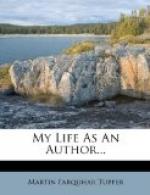charmed with a curious antique font, and the tower,
an octagon gothic lantern with extinguisher atop,
like this: as far as memory serves me.
Onward again, through St. Blazey, and a mining district,
not ill-wooded, nor unpicturesque, to the fair
town of St. Austle, which the piety of Cornish
ancestors has furnished with another splendid
specimen of ecclesiastical architecture, the upper
half of the chief tower, a square one, being
fretted on every stone with florid carving, and
grotesque devices: but what shall I say of Probus
tower, which from top to bottom is covered with delicate
tracery cut in granite? it rises above the miserable
surrounding village, a satire upon neighbouring
degeneracy in things religious: you must
often have seen drawings of Probus at the Watercolour
Exhibition, as it is a regular artists’
lion. At about half-past six we got into
Truro, a clean wide flourishing town with London shops,
a commemorative column, a fine spired church, bridges
over narrow streams, and, like most other West
of England towns, well payed and gas-lighted.
From this, I had intended to go to Falmouth, but
a diligent brain-sucking of coach comrades induced
me to jump at once into a branch conveyance to
Penzance, so passing sleepy Redruth, Camborne,
and St. Erth in the dark, I found myself safely housed
at the Union Inn, Penzance, at half-past eleven.
Talking of unions, the country is studded here
as everywhere with them; fine buildings put to
the pernicious use of imprisoning for life those whose
only crime is poverty, and destined to be metamorphosed
ere long (so I prophesy) into lunatic asylums
for desperate ministerialists, prisons for the
Chartists, veterinary colleges for cattle with
the rot, and as one good end, hospitals for the poor.
Near Redruth, I took notice in the moonlight of
Carn-breh, the remains of a British beacon or
hill-fort, much of the antiquarian interest of
which has been destroyed by a neighbouring squire
having added to it modern ruins, to make
it an object from his hall! the whole hill, like
much of the country, is sprinkled with granite
blocks higgledi-piggledy, and it is a grand dispute
among the pundits, whether or not the Archdruid
Nature has been playing at marbles in these parts;
I wished to satisfy myself about it, but couldn’t
stop, and so there’s no use in grummering about
regrets. I’ve seen enough, to be able
to judge a priori, that father Noah’s
flood piled the hill with blocks, which have served
one Dr. Borlase and others as occasions for earning
the character of blockheads. One thing is
man’s doing, without much dispute, and
that is, an obelisk in honour of old Lord De Dunstanville,
which is a conspicuous toothpick on the hilltop:
no doubt, as in this case, nature brought the
stones there, and man did his part in arranging them;
poor Dr. B. would have you believe that every natural
rock had been lifted here bodily for architectural
purposes, and as bodily made a most elaborate
and labyrinthine ruin afterwards. At Penzance,




